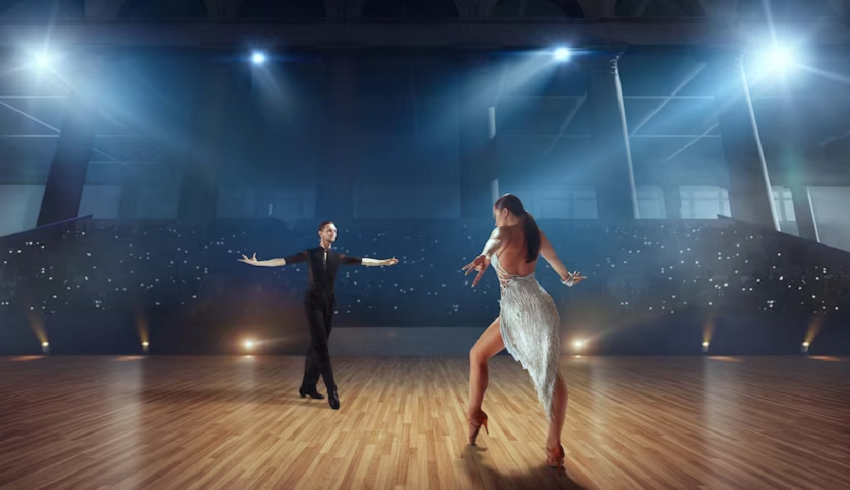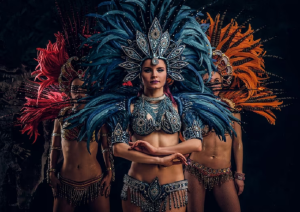The rhythm of the drums pulses through the air as dancers move their hips and feet in vibrant synchronization. This captivating scene is none other than the Samba dance—a dynamic and exuberant Brazilian dance style that has captured the hearts of people around the world. From its humble origins in the streets of Rio de Janeiro to its global popularity today, the history and evolution of Samba dance moves are a testament to the rich cultural tapestry of Brazil and its influence on the world of dance.
Before we dive into the journey of Samba dance moves, let’s take a moment to appreciate the dazzling allure of Samba dance costumes. If you’re curious about the intricate and flamboyant attire that complements the energetic movements of Samba dancers, you can explore the samba dance costumes details to get a glimpse of the stunning ensembles that contribute to the visual spectacle of this dance form.
A Glimpse into the Roots of Samba Dance
The roots of Samba dance can be traced back to the vibrant neighborhoods of Rio de Janeiro, where African, European, and indigenous cultures intermingled to create a unique and dynamic artistic expression. The early forms of Samba were closely associated with the Afro-Brazilian communities and their celebrations. Samba’s rhythmic beats and spirited movements embodied the spirit of liberation and joy, often celebrated during festivals and street parties.
As Samba dance grew in popularity, it came to symbolize the essence of Brazil’s cultural heritage, reaching beyond societal and economic divisions. As the years passed, Samba’s evolution saw it absorbing elements from diverse dance styles, resulting in a unique fusion of African, European, and indigenous influences that contribute to its distinct character. This dynamic amalgamation has transformed Samba into a vibrant embodiment of Brazil’s rich cultural tapestry.
Evolution of Samba Dance Moves
The evolution of Samba dance moves is a reflection of Brazil’s diverse cultural heritage and the dance’s ability to adapt and innovate over the years. From the traditional to the contemporary, Samba dance has undergone several transformations while retaining its core spirit and energy.
-
Samba de Roda
One of the earliest forms of Samba dance is known as Samba de Roda. This style is characterized by a circular formation of dancers who move in unison to the beat of drums and other traditional instruments. The circular arrangement symbolizes unity and community, and the movements involve intricate footwork, hip sways, and joyful interactions among the participants.
-
Samba no Pé
Samba no Pé, also known as “Samba in the Foot,” is a solo style of Samba that emphasizes precise footwork and hip movements. This style gained prominence in the urban areas of Brazil and is often seen in carnival parades and Samba schools. Dancers showcase their agility and creativity through complex foot patterns, syncopated rhythms, and spirited shimmies.
-
Samba de Gafieira
Samba de Gafieira is a partner dance style that emerged in the dance halls of Brazil. This elegant and sophisticated form of Samba combines elements of Samba with ballroom dance techniques. Partners engage in intricate footwork, dips, spins, and close embraces while moving gracefully across the dance floor. Samba de Gafieira showcases the fusion of different dance traditions and the adaptability of Samba to various contexts.
-
Contemporary and Fusion Styles
In contemporary times, Samba dance has continued to evolve through fusion with other dance styles and global influences. Dancers and choreographers have incorporated elements from jazz, hip-hop, and even modern dance into their Samba routines. This cross-cultural exchange has led to innovative choreography and the expansion of Samba’s artistic possibilities.
Preserving Tradition while Embracing Innovation
Amid the evolution and diversification of Samba dance moves, a deliberate commitment to safeguard its cultural core and historical importance persists. Within Brazil, Samba remains an inseparable facet of the nation’s identity, a prominent presence at festivals, parades, and cultural gatherings. Samba schools serve as pivotal bastions for both instructing and showcasing the dance, assuming a pivotal role in transmitting the tradition to successive generations. This dedicated effort ensures that Samba’s legacy endures, passing its rhythmic heritage on to the hands and feet of those who will shape its future.
Conclusion
The history and evolution of Samba dance moves encapsulate the essence of Brazil’s cultural mosaic and its impact on the world of dance. From the rhythmic celebrations of Samba de Roda to the elegance of Samba de Gafieira, each style tells a unique story of tradition, adaptation, and innovation. As Samba continues to captivate audiences worldwide, it pays homage to its roots while embracing the dynamic changes of the modern age. This vibrant dance form serves as a testament to the power of music, movement, and culture to transcend boundaries and unite people in celebration and joy.





